Ask any ballplayer and he’ll tell you the importance of scoring runs in the first inning. “It sets the tone for the rest of the game,” or, “It gives you momentum,” are just a couple of the common phrases you may hear.
As someone who has said some of these phrases, I can tell you the players are right. It is extremely important to score in the first inning, and data proves it. The first inning is responsible for more runs scored in a game than any other inning. If we look at the total runs by inning from the 2015 to 2018 seasons, this trend is shown loud and clear. (Keep in mind that the ninth inning will always be responsible for fewer runs because not every game reaches the bottom of the ninth.)

Why does this matter? Well, basic math and observation would tell you that if the bulk of your runs are scored in the first inning, and if your team doesn’t score in that inning, then you have a lesser chance of scoring. If we add up all the runs scored in each inning from 2015 to 2018, then this becomes much more obvious.
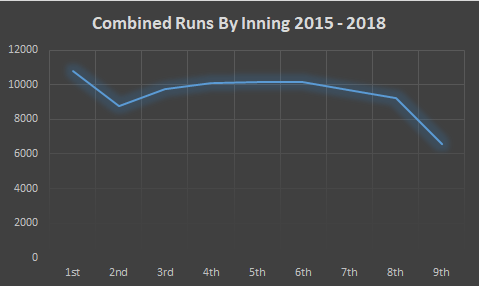
Regardless of statistical or empirical evidence, the conclusion is the same: Score in the first inning if you want a better chance of winning.
None of this information should be shocking or new to you. In my opinion, this run production is simply a product of the lineup that a manager crafts. The first three hitters in any lineup are almost always that team’s best run producers, so it only makes sense that when the best three hitters are guaranteed to hit, the team scores the most runs. You could equally choose to blame the pitching for this trend. It isn’t uncommon for a pitcher to struggle in the first inning because of a need to “settle in” and get adjusted with the umpire’s strike zone (just look at Madison Bumgarner).
But how do we quantitatively measure it? And how do we distinguish what outings a pitcher “didn’t have it” or when the hitters were just better? Maybe it’s my bias toward hitting, but I’d much rather give credit to the hitters for their good work than blame the pitchers. Regardless of your reasoning, the outcome is the same.
So if scoring runs with those first three hitters is important, then a team’s leadoff hitter must be pretty important, right? He’s the batter who determines if the inning starts with one out and nobody on base or no outs and a man on base or maybe even a run. This observation left me asking a question that you might be asking yourself right now: Who is the best leadoff hitter in the MLB this year?
Well, as hinted by the article’s name, it’s Texas Rangers designated hitter and outfielder Shin-Soo Choo.
But like TV salesperson Billy Mays would say, “WAIT … there’s more!” Choo doesn’t just lead qualified leadoff hitters in first-inning hitting, he leads all hitters!
Shin-Soo Who??
Formerly a pitcher, Choo signed with the Mariners in 2000 and began his conversion to the outfield. He’s been a slightly above average hitter for the majority of his career, showing his peak performances in 2010 with the Indians, where he had a .386 wOBA, 145 wRC+, and 22 homers, and in 2013 with the Reds, posting a .393 wOBA, 150 wRC+, and 21 homers. This season hasn’t been up to the standards of his best two, but he is still producing, especially as a hitter who just turned 37.
This season, he’s slashing .283/.379/.499, has 17 homers, a .371 wOBA, and a 126 wRC+. Those numbers hold their own, but it’s what he is doing in his first plate appearance of each game is the reason why he’s so exciting.
Choo Lead, I’ll Follow
Choo, aka Tokki 1, has been the best hitter in the first inning by a landslide. Among hitters with at least 40 plate appearances in inning No. 1, Choo is first in slugging percentage, OPS, wOBA, wRC+, hits, run, extra-base hits, and, for what it’s worth, getting hit by pitches! Choo is second in OBP (.505) to only Juan Soto. Take a look at the table below and you’ll see how much better Choo has been in the first inning than any other hitter:
| Hits | XBH | Runs | HBP | AVG | SLG | OPS | wOBA | wRC+ | |
| Choo | 34 | 17 | 24 | 5 | 0.430 | 0.823 | 1.328 | 0.545 | 239 |
| Next Guy | 29 | 13 | 20 | 4 | 0.418 | 0.766 | 1.196 | 0.491 | 209 |
Choo is tied for fourth in first-inning homers at seven and tied for first in home runs by a leadoff hitter with six. He also leads all leadoff hitters in OBP.
So what is the key to Choo’s dominance in the first inning? What is he doing that no other first inning hitter is?
Well for starters, Choo is fourth in the league in hard-hit rate (53%) and 16th in total hard-hit batted balls (134), so it’s safe to assume that a lot of this hard contact is coming in the first inning. And sure enough, it is! Choo’s average exit velocity in the first inning is 93.7 mph. Possibly the most intriguing stat is Choo’s infield hit rate of 0%. This tells us that Choo does not have a single infield hit in the first inning and hints that his production could be direct result of great quality of contact.
His hard contact paired with an 8.4% walk rate in the first inning further suggests that his wOBA and OBP are coming mainly from hits.
Choo’s first-inning swing rate and season swing rate are virtually identical, 41.1% and 41.6%, respectively. This doesn’t suggest a change to Choo’s approach and actually tells us the opposite. Choo is being just as patient as he would be in any inning. In fact, Choo is seeing pitches in the zone in 53.4% of his total first-inning pitches, nearly 9% higher than his season zone rate It’s perfectly reasonable that pitchers are attacking Choo because of the low leverage that comes with being a leadoff hitter, but to Choo’s credit, he’s making his swings pay off.
First, let’s see how many pitches he is swinging at:

Now out of all the pitches he’s swung at in the first inning, let’s look at how many he’s made contact on:
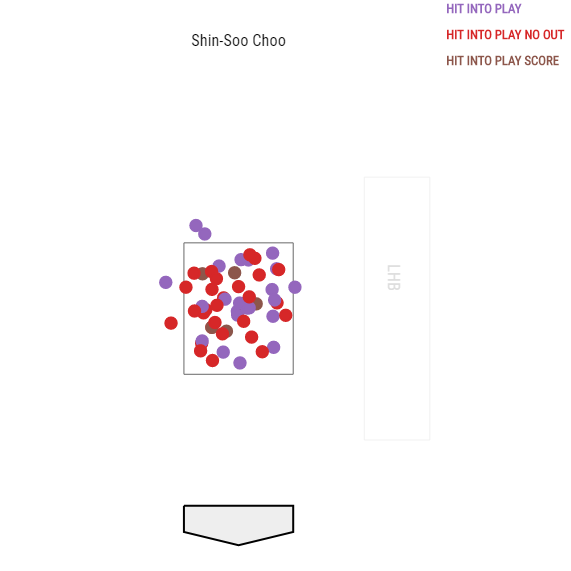
Choo has swung at 144 total pitches and put a ball in play 41.7% of the time. Remember what I said about his exit velocity? Let’s see that on first-inning batted balls:

Noted by the red data points, that’s a lot more hard contact than soft contact for Choo. In fact, Fangraphs has Choo’s first-inning hard-contact rate recorded at 59.3%! Consistent swings paired with high exit velocity seems like quite the deadly combination for a leadoff hitter.
So where is Choo’s hard contact going? Just about everywhere:
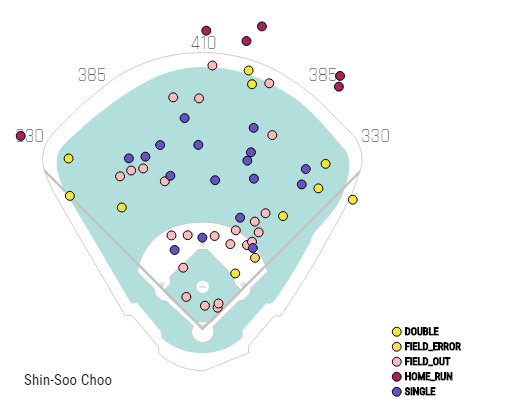
On average, Choo is pulling the ball at 40.7%, hitting it middle at 39%, and opposite field at 20.3% but still manages to scatter the ball around the outfield. Paired with such a high hard-contact rate, his pull rate is not worrisome at all. But if my word isn’t good enough for you, take a look at his slugging percentage based on pitch location:

Choo is covering the plate, and he is doing it with power. Again, this could be a result of how pitchers attack him, but Choo is hammering pitches no matter where they are thrown, and he is doing it with frequency. I stated earlier that he leads the league in leadoff homers, so now is a good time to take a look at one:
https://gfycat.com/recklessanotheramethystinepython
And if that still isn’t good enough, watch him turn on a 97 mph heater from Astros starter Gerrit Cole:
https://gfycat.com/powerfulflawedargentinehornedfrog
Right in the Wheelhouse
We have already established that pitchers are throwing a lot of strikes to Choo, so let’s look at what these pitches are:
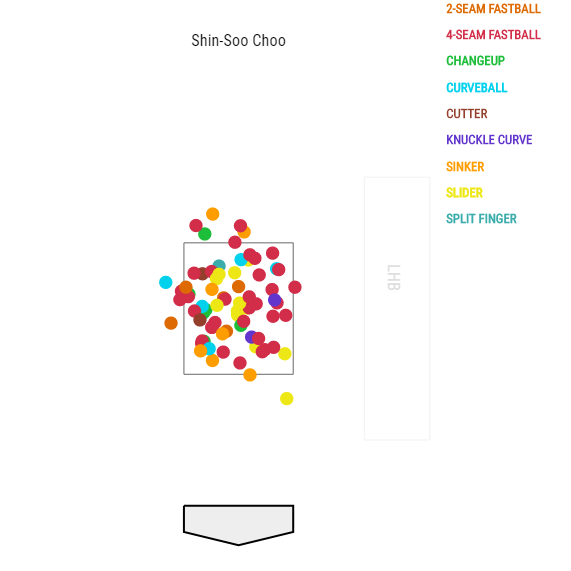
Well, this one is pretty clear. Choo is getting predominately fastballs and not many offspeed pitches. And in what counts is Choo getting these fastball? Every count:
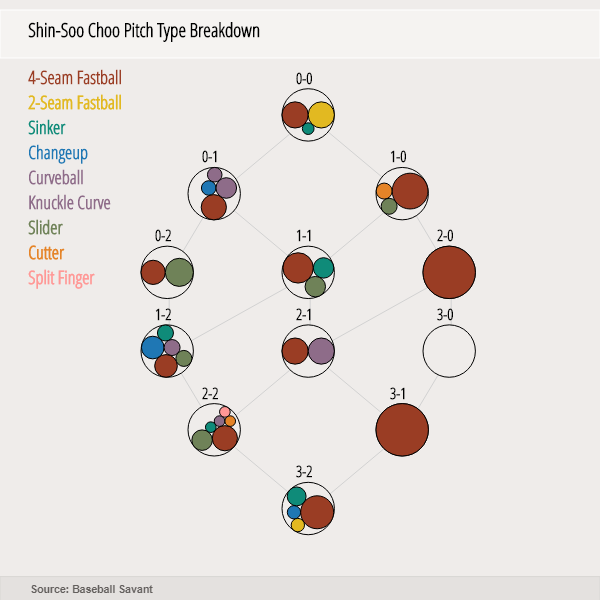
Choo has posted six MLB seasons with a wFB (runs above average on fastballs) above 20, including his 2013 season, when his wFB was an absurd 52.7.
This season is no different. Choo’s wFB is currently 13.5, the seventh-best in the AL.
Pitchers need to reevaluate how they approach the Rangers’ leadoff hitter, because right now Choo is the last hitter a starting pitcher should want to face to start a game, and fastballs are doing nothing to change it.
Biggest Takeaways
There’s a lot to pull from the evidence presented above, but here is my conclusion: Shin-Soo Choo’s first-inning success comes from his ability to hit fastballs hard. I think Choo knows that he is going to get a steady diet of fastballs as a leadoff hitter and stays patient in his approach looking for the perfect one to drive. As in any of his at-bats, he looks to do damage on pitches in the middle of the zone, specifically on heaters.
For some hitters, it might be hard to build an approach geared toward the pitches you’re likely to get pitched instead of just the pitches you want to hit. This is no problem for Choo in the first inning as the excellent fastball hitter is consistently getting exactly the pitch he wants—and usually right over the heart of the plate.
Even with his tremendous success, it’s important to note that this type of production is highly unlikely to be sustainable. Still, in the first inning, Choo’s xBA sits at sixth in the league (.341), his xwOBA is fifth in the league (.447), and his xSLG is seventh in the league (.641).
Nonetheless, Choo is still arguably a top-30 hitter, easily a top-40 hitter, and consistently gets on base in front of a powerful Joey Gallo. For fantasy context, he is owned in 70.7% of ESPN leagues. His ownership rate is lower than the following outfield-eligible hitters, all of whom he is outperforming:
- Starling Marte (98.2%).
- Andrew Benintendi (97.6%).
- David Dahl (93.5%).
- Lorenzo Cain (92.0%).
- Nicholas Castellanos (89.3%).
- Nick Markakis (84.6%).
- Joc Pederson (79.8%).
- Dee Gordon (79.7%).
- Nomar Mazara (74.6%).
- Alex Gordon (72.9%).
By no means am I suggesting you should go trading away one of these guys for Choo. Some of these guys undoubtedly have more fantasy upside than him. But, almost all of these hitters’ names will hold more weight and sound more valuable than a guy like Choo. Trading for Choo may SEEM like a downgrade (it isn’t), but if you can get him while improving another aspect of your team, that’s a great deal. Either way, he’s someone to keep your eye on.
